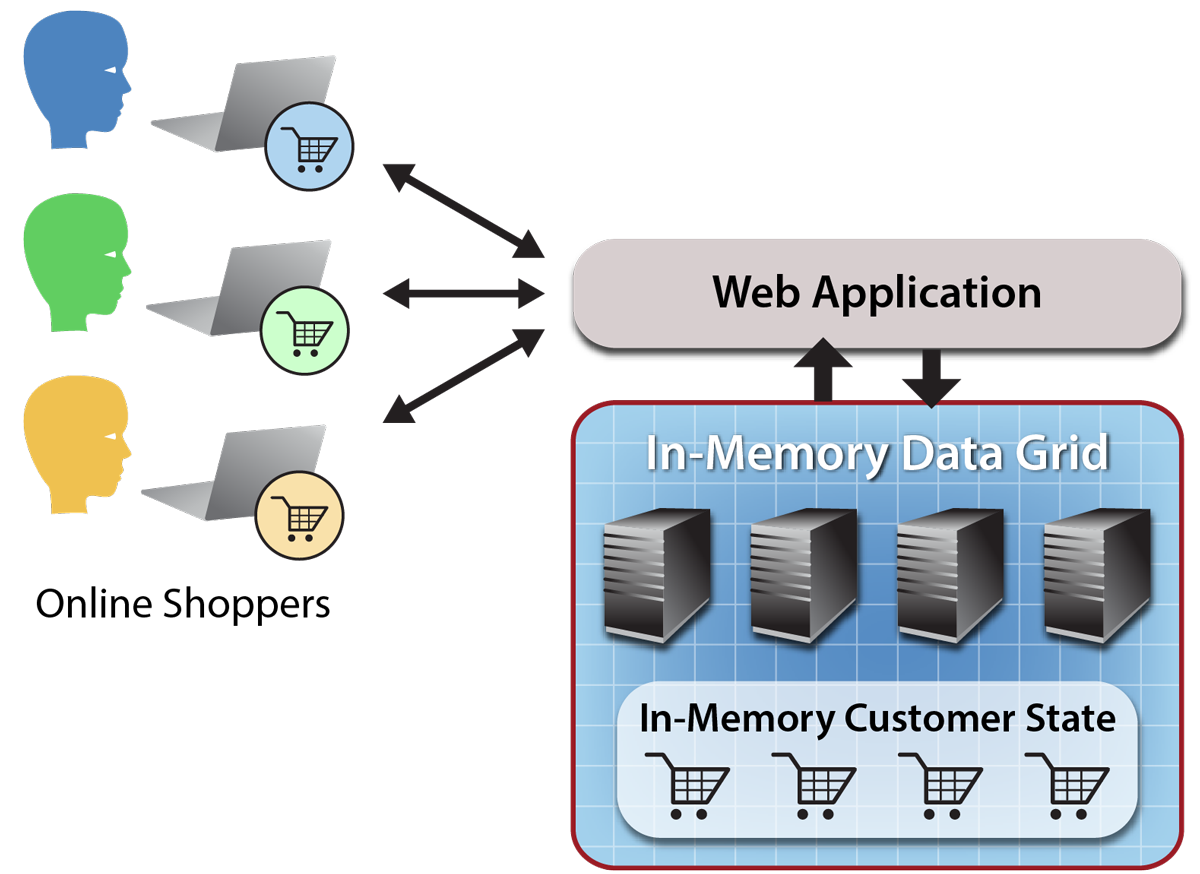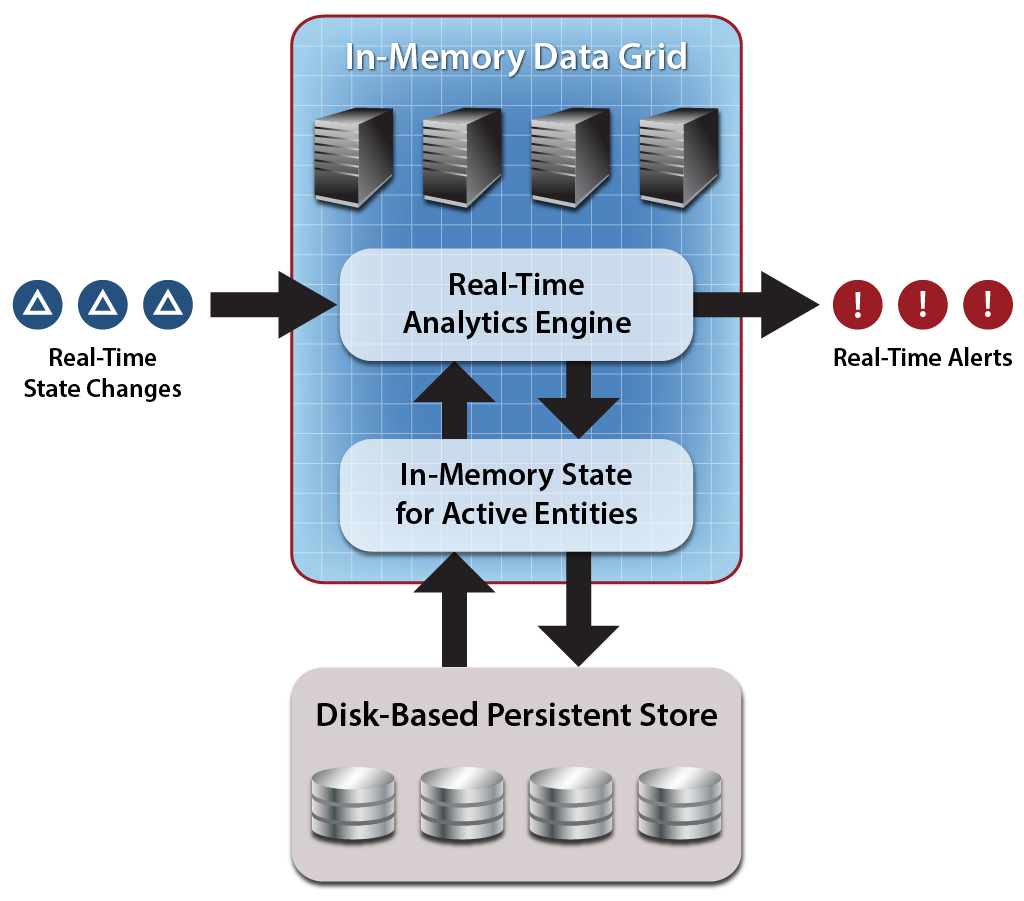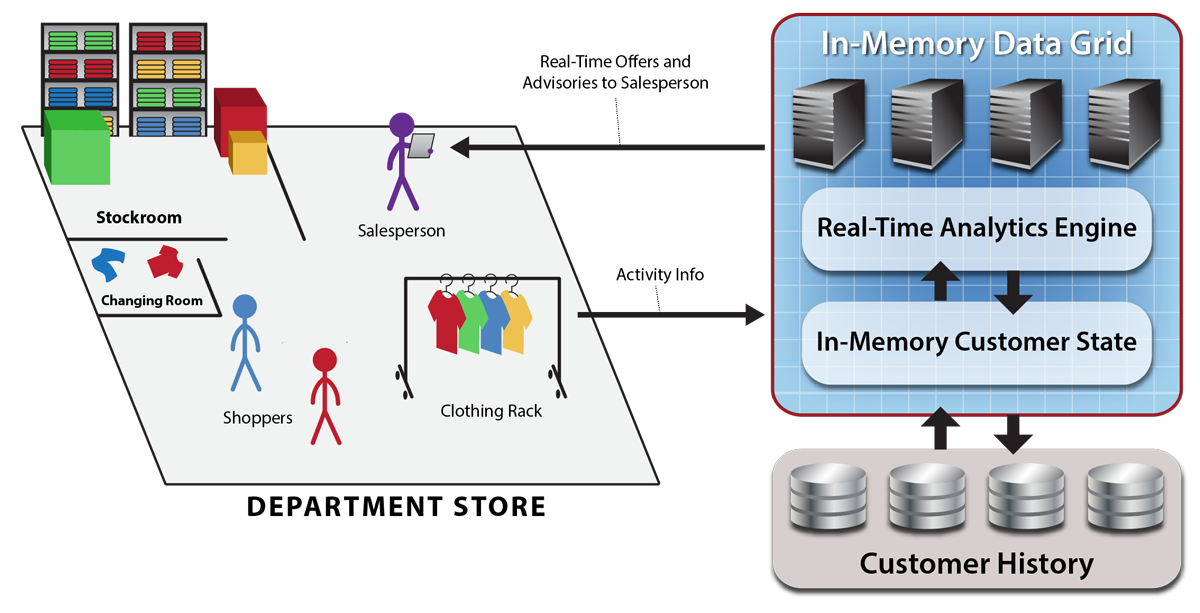Real-time analytics has the potential to transform operational systems by providing instant feedback that dramatically enhances how these systems respond to fast-changing events. For example, in a previous blog we saw how a hedge fund tracking its equity portfolios can respond to market fluctuations in milliseconds instead of minutes. However, these benefits are not restricted to financial services. In discussions with both e-commerce and brick-and-mortar retail companies, we also have identified opportunities to enhance their operational systems with real-time analytics. Let’s take a look at a few examples after a quick review of in-memory data grids (IMDGs).
Operational Systems Need In-Memory Data Grids
Operational systems typically manage fast-changing client data that constantly streams in for processing by business logic, which updates existing state information and initiates appropriate responses. Some responses provide feedback to clients and others commit changes to persistent storage. For example, an e-commerce system receives requests to view products from web browsers, displays requested products and offers, and sends requested information back to clients. It also receives orders from clients, which it commits to permanent storage, and then it sends out messages to other systems to process these orders.
In-memory data grids (IMDGs) have been used for several years within operational systems to ensure fast responses and to scale throughput as workloads grow. In-memory data grids enable the execution of business logic to scale out across a cluster of servers while holding fast-changing application state in memory accessible to all servers. Memory-based data storage helps minimize response times, and servers can add CPU capacity to handle incremental growth in the workload.
For example, an in-memory data grid can hold session state and shopping carts for an e-commerce web farm, enabling all web servers to quickly and seamlessly access this data as they handle incoming browser requests (which are distributed by an IP load-balancer to web servers):

In-Memory Computing: The Engine of Real-Time Analytics
The next step for operational systems is to add real-time analytics, and the easiest way to insert real-time analytics into an operational system is to integrate it with the system’s business logic using an IMDG. By adding real-time analytics to an in-memory data grid, it becomes instantly available to analyze fast-changing data flowing through the system and produce immediate results:

As we have explored in previous blogs, the key to fast response times for real-time analytics is data-parallel programming, that is, examining many data items in parallel using a single algorithm. This approach has two major strengths: (a) it enables the algorithm to be distributed across the grid’s cluster of servers for fast execution, and (b) it avoids moving data between servers for processing. The net result is that large, memory-based data sets can be quickly analyzed to generate timely responses.
Some IMDGs, such as ScaleOut Analytics Server, offer an integrated real-time analytics engine that automatically ships analytics code to all grid servers and then executes the code in parallel on a specified collection of data stored within the IMDG. This simplifies the task of embedding real-time analytics within an operational system and ensures high performance.
Real-time analytics also can be constructed using the Hadoop MapReduce programming model, which offers a very popular data-parallel design pattern. ScaleOut hServer hosts Hadoop MapReduce applications using its real-time analytics engine and eliminates the overheads of task scheduling and data motion usually associated with Hadoop, thereby opening the door to using MapReduce in operational systems.
Adding Real-Time Analytics to an E-Commerce System
Let’s look at how real-time analytics can be integrated into an e-commerce system. In addition to sending basic page requests to the system from clients browsing a website, the browser also can be instrumented to send detailed information about which products customers are examining and the time they are spending on each product. Combining all of this information, the system can build a history of site usage for each customer and collect a set of preferences for that customer. To support a large population of customers, customer information can be persisted in a database or NoSQL store and then brought into the IMDG when the customer starts browsing.
As illustrated in the following diagram, real-time analytics can continuously examine all active customers in parallel to identify special offers that are appropriate for the customer based on a combination of his/her preferences, shopping history, and current browsing behavior. By analyzing access patterns, the site also can determine if a customer is having difficulty finding products or services and suggest remedies. Inactive customers can be flagged and sent emails to remind them to complete purchases in their shopping carts. In addition, common patterns across customers can be identified and used to steer strategic decisions influenced by buying trends.

Using Real-Time Analytics in a Brick and Mortar Retail Store
As e-commerce has gained increasing dominance with the shopping public, brick and mortar stores have responded by personalizing the shopping experience. High end retailers are now beginning to send real-time information from the point of sale to back-office servers for analysis in order to provide immediate feedback to sales staff. This enables the retailer to dramatically enhance the shopping experience.
For example, opt-in customers can identify themselves to sales staff on arrival so that their preferences and history can be used to help suggest products of interest. Products can be tracked with RFID tags to alert the sales staff when an active customer’s size is not present on the sales floor and must be retrieved from the stockroom (preferably before the customer requests it). These tags also can identify which products are being taken from the shelves or racks so that buying trends can be tracked. This also helps the store determine which products are repeatedly left in the changing rooms and not purchased, increasing the store’s buying power with the manufacturer. These are some of the many potential uses for real-time analytics in brick and mortar retail.
As the following diagram illustrates, IMDGs with integrated real-time analytics provide a fast and highly scalable platform for hosting customer information and analytics algorithms used by brick and mortar stores. Streams of information regarding customer activity and product motion can be fed to an IMDG to update in-memory state information for customers and products. Using data-parallel execution, analytics algorithms can continuously analyze this in-memory state and generate alerts for the sales staff which are delivered to point of sale terminals or tablets.

Summing Up
These examples show the power of real-time analytics to enhance operational systems which manage retail purchases, whether online or in brick and mortar stores. By hosting real-time analytics within an IMDG, these systems easily can host customer and product information which is repeatedly updated by streams of activity data. Unlike pure streaming systems, IMDGs can integrate these two types of information to provide a more complete picture of customer activity, leading to a deeper understanding of behavior, preferences, and customer needs. Lastly, IMDGs which host data-parallel analytics algorithms can deliver fast results, avoiding the batch processing overheads of conventional analytics systems, while ensuring scalable performance to handle growing workloads.
